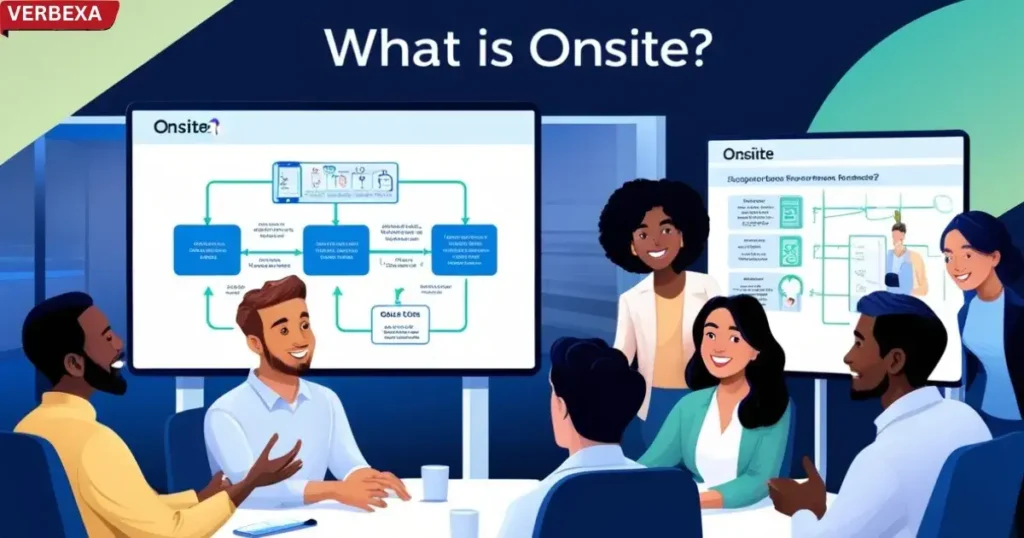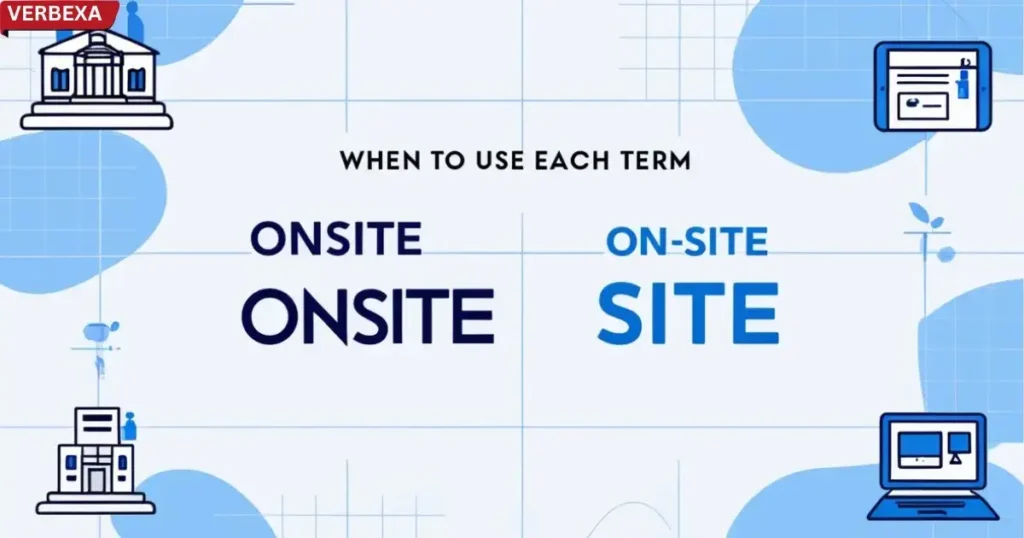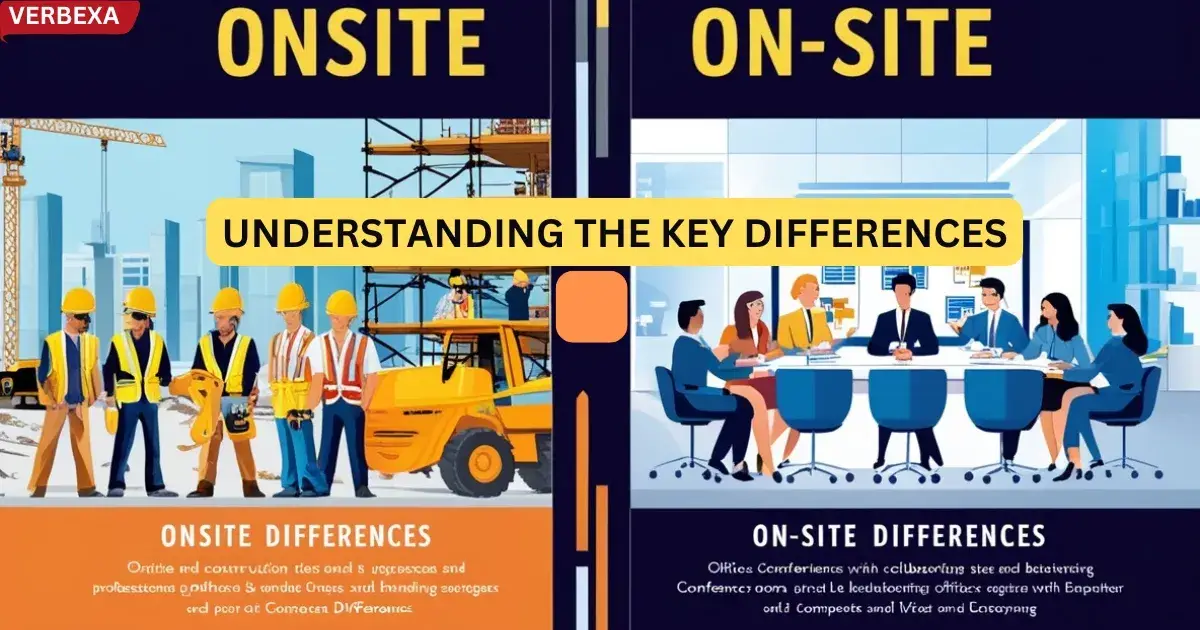Are you confused about when to use onsite versus on-site? Many people struggle with this seemingly minor grammatical detail. Imagine this scenario: You’re writing an email to your boss about an upcoming onsite meeting.
Should you write “onsite” or “on-site”? The seemingly small difference might impact the overall readability and formality of your writing. This article will clarify the nuances of onsite or on-site, guiding you toward confident and correct usage in any context. We’ll explore the contextual usage, hyphenation, and the impact on formality in your writing.
The Great Onsite/On-Site Debate

The terms “onsite” and “on-site” are often used interchangeably, leading to confusion. This is because they essentially mean the same thing: located at or occurring at a specific physical location, or site. However, the presence or absence of a hyphen significantly alters the formality of the word and its appropriateness in different writing styles.
Choosing between on site or onsite isn’t merely about adhering to stylistic guidelines; it’s about conveying a professional image and ensuring clear communication. For instance, an informal email to a colleague might use “onsite,” while a formal report would opt for “on-site.” Understanding this distinction will elevate your writing.
Definitions and Grammatical Roles
What is Onsite?

Onsite is an adjective describing something located or happening at a specific physical location. It represents a more modern, condensed approach to describing location-specific activities.
What is On-Site?

On-site is the traditional, hyphenated version of the term, preferred in more formal writing and professional documents. It maintains the same fundamental meaning as onsite but with a more structured grammatical presentation.
The grammatical role of both terms is the same; however, the stylistic choice directly impacts the overall tone and perception of your writing. Using “on-site” in informal contexts might seem overly stiff, while employing “onsite” in formal settings might appear unprofessional. Therefore, understanding the contextual usage is crucial.
Synonyms Exploration
Onsite Synonyms:
- Location-based
- Present
- In-location
- Local
- Immediate
- Direct
- Proximate
- Resident
- Situated
- Concurrent
On-Site Synonyms:
- Location-specific
- At-location
- Immediate
- Direct
- Present
- Proximal
- Resident
- In-place
- Colocated
- Immediate-location
Comparison Table: Onsite vs On-Site
| Feature | Onsite | On-Site |
|---|---|---|
| Definition | Located at or occurring at a specific site. | Located at or occurring at a specific site. |
| Formality | Informal | Formal |
| Hyphenation | No hyphen | Hyphenated |
| Usage | Casual conversations, emails, informal writing | Formal reports, academic papers, professional writing |
| Readability | High, due to brevity | High, due to clear separation of words |
| Example | We had an onsite meeting today. | The on-site engineers completed the installation. |
When to Use Each Term: Onsite Or On-Site

Use “onsite” when
- Writing informally.
- Communicating with colleagues or friends.
- Using a concise style.
- Creating marketing materials with a less formal tone. For example, “Our onsite technical support team is available 24/7.
Use “on-site” when
- Writing formal documents.
- Preparing official reports.
- Working on academic papers or scientific publications.
- Complying with a specific style guide (like AP Style) that dictates the use of hyphens in compound adjectives. For instance, “The report highlighted the need for improved on-site security measures.” This clarifies the semantic entities involved, emphasizing the formal nature of the writing.
Practical Usage Examples
Here are a few more examples showcasing the correct use of onsite or on-site in various contexts:
- Informal: “I’m working onsite today, so I’ll be a bit late for the call.”
- Formal: “The project manager will oversee all aspects of the on-site installation. “
- Informal: “We’ll need onsite parking for all the attendees.”
- Formal: “The on-site facilities include a cafeteria and a fitness center.”
- Informal: “The onsite training sessions were very helpful.”
- Formal: The on-site technical support provided by the vendor resolved the issue promptly.
These examples highlight the versatility and adaptability of both terms, demonstrating how the choice between “onsite” and “on-site” depends largely on the formality required in the specific context. When making your selection, consider the audience and the overall tone of your communication.
Remember that “on-site” is usually more appropriate for business writing, official documents, or when aiming for maximum clarity and professionalism.
Contextual Nuances

AP Style Guidelines
The Associated Press (AP) Stylebook recommends on-site in formal writing, highlighting the importance of hyphenation in professional communication.
Regional Variations
- UK English: Prefers on-site
- US English: More flexible, accepting both onsite and on-site
- Australian English: Tends to use on-site in formal contexts
Common Mistakes to Avoid
- Don’t mix onsite and on-site within the same document
- Consider your audience’s expectations
- Be consistent in your contextual usage
FAQs
Is it working on site or onsite?
Both are acceptable, but “on-site” is generally preferred in formal writing for improved clarity. “Onsite” is perfectly fine in informal settings.
Is it on site or onsite or on sight?
“On site” and “onsite” mean at a specific location; “on sight” means visible. Choose the appropriate term based on the intended meaning.
Is on site all one word?
No, “on site” is typically two words in formal writing, but it can be written as one word (“onsite”) in informal contexts.
What do you mean by onsite?
“Onsite” means located at or occurring at a specific physical place. It’s the shorter, less formal version of “on-site.”
Conclusion: Mastering Onsite vs On-Site
The distinction between onsite or on-site might seem subtle, but it carries significant weight regarding style and professionalism. While both indicate a location at a specific site, the hyphenated version “on-site” elevates the formality of your writing. Understanding this simple difference can drastically improve the clarity and impact of your communication. By carefully considering the context and your intended audience, you can ensure you consistently use the correct term, enhancing your writing’s readability and overall effectiveness.
Remember to prioritize clarity and choose the term that best aligns with the formality level of your communication. Whether you opt for the concise “onsite” or the more formal “on-site,” the accurate use of these terms reflects attention to detail and enhances the overall impact of your writing.

This author is a passionate linguist and grammar enthusiast, dedicated to helping individuals master the art of language. With years of experience in teaching and editing, she brings clarity and precision to every sentence. Tina’s mission is to empower writers of all levels to express themselves with confidence and excellence.

